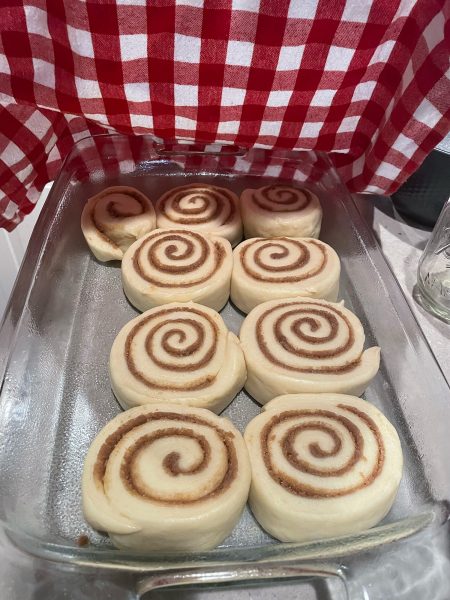Juuling: A New kind of Smoking
June 1, 2018
Over the past few years, the U.S. has seen a decrease in the use of cigarettes and an increase in the use of e-cigarettes also called vapes. Most recently, there has been a spike in the use of a new vape product called the Juul.
The Juul is barely 9cm long and 1.5cm wide, the size and weight of a long USB stick. The Juul comes with four different flavor pods — Cool Mint, Fruity Medley, Crème Brûlée and Virginia Tobacco — that are easily inserted into the device. Once each “pod” or e-juice cartridge is inserted into the Juul device, it is then heated up into vapor to smoke. On the official Juul website, a Juul device is $34.99 while a four-pack of pods are $15.99.
According to Vape360 writer Dave Kriegal, “The Juul pods hit extremely hard as they have a high nicotine level while also using a salt based nicotine. This is to mimic the throat hit you would experience by smoking.” On the official Juul website, the company promises a “powerful vapor experience” and says the nicotine in one is equivalent to an entire pack of cigarettes, “or 200 puffs.”
The nicotine component of Juuls has increasingly shown addictive features, similar to the nicotine component in cigarettes. According to Forbes writer Sally Satal, “Nicotine was deemed to have addictive properties based on three fundamental features: (1) in the initial stages of use, more of it is required to produce the same effect in the smoker, a phenomenon called ‘tolerance;’ (2) it is ‘reinforcing,’ meaning that it is sufficiently rewarding to spur self-administration; and (3) abrupt cessation can lead to powerful craving and a recognizable withdrawal syndrome.”
The health risks that come from Juuls should concern users — especially young ones. When students were asked about the health effects and the addictive nature of nicotine one student said, “I do know the health problems that come with Juuling, but I can’t stop using it because I’m addicted.”
While another student disagreed saying, “I’m not addicted. I only Juul when I go out on the weekends and try to use it as little as possible.”
Dean of Students Shane Lopes comments on nicotine addiction, “I don’t think Juuling is a better option [than cigarettes]. I see [Juuling] as another way of becoming addicted to the same chemical.”
Juuling has become a huge epidemic for younger generations. The Juul company’s mission statement is “to eliminate cigarette smoking by offering existing adult smokers with a better alternative to combustible cigarettes.” They go on to state, “We strongly condemn the use of our product by minors, and it is, in fact, illegal to sell our product to minors.” This means no student at any high school should be in the possession of a Juul product, but this is not the case. “Juuls are super easy to buy,” according to an anonymous student.
Part of the Juul’s appeal is that it is hard to notice. When comparing this to other e-cigarettes and conventional cigarettes, a student said, “The Juul is way more convenient in terms of use. You can use it anywhere, and it is discreet. It doesn’t have a smell, it’s small and it’s portable.”
The style of the Juul is very inviting for teenagers.
When asked how they started using the Juul, users’ responses were mixed. One student said, “I started as an alternative to cigarettes because of the smell and the taste.”
Another student said, “I started using the Juul because I enjoyed the feeling of the head rush from the nicotine.” While some of the others replied similar answers as this student, one said, “I don’t know why I started. It just happened and I got one.” It’s troubling that most interviewees didn’t even have a reason to why they started, they just did.
Juul use has been a recent topic in school assemblies. Lopes has spoken both to the student body and the football team about Juuls being brought on campus. Lopes comments on the use of Juuls by teenagers saying, “I don’t know how much of a problem Juuling is for teenagers, but I’m noticing that more people are involved in Juuling then they are smoking cigarettes.”
When asked if Juuling is becoming a problem among teenagers an anonymous student said, “It’s becoming a problem with teenagers because people are not taking into account the health problems that it has and what it could do to you because no one knows what [the Juul] really is because it’s so new. Everyone just hopped on the train and started using it.”
Some of the students interviewed have actually decided to give up Juuling, but have returned to a box mod vape that has a significantly lower amount of nicotine present than the Juul. Another student threw away his or her Juul because “after a few months I realized that I was spending way too much money on pods and that it wasn’t healthy. I really just didn’t need to be doing it, so I just decided to throw it away.”
However, it isn’t easy for every Juul user to get rid of their Juul. According to this anonymous student, “I tried to get rid of [my Juul] in the new year, but I [had] already spent money on new pods and didn’t want to waste them.”
When asked about what he wishes readers to take away from this article, Shane Lopes said, “I would like students to have a greater understanding of the risks of becoming addicted to any particular drug and also understand why students or individuals, in general, choose to get involved with Juuling, to begin with.”


















